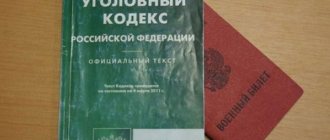ST 357 of the Criminal Code of the Russian Federation.
Actions aimed at the total or partial destruction of a national, ethnic, racial or religious group as such by killing members of that group, causing serious harm to their health, forcibly preventing childbearing, forcibly transferring children, forcibly relocating or otherwise creating conditions of life calculated to bring about physical destruction members of this group are punishable by imprisonment for a term of twelve to twenty years with restriction of freedom for a term of up to two years, or life imprisonment, or the death penalty.
Commentary to Art. 357 Criminal Code
1. The objective side of genocide is characterized by the commission of actions aimed at the complete or partial destruction of a national, ethnic, racial or religious group as such, by means specified in the law, adopted from the Convention on the Prevention and Punishment of the Crime of Genocide of December 9, 1948.
2. A national group is a historical community of people that takes shape during the formation of a common territory, economic ties, literary language, and some cultural and character features that constitute its characteristics.
An ethnic group is a historically emerged stable social group of people united by long-term cohabitation in a certain territory, a common language, culture and identity. Additional conditions may include common religion and racial proximity.
A racial group is recognized as a historically established group of people connected by a unity of origin, which is expressed in common hereditary morphological and physiological characteristics, varying within certain limits: the color of the skin, eyes and hair, the shape of the eyes, the structure of the eyelids, the outline of the head, etc.
A religious group is a group of people professing a common religion, i.e. belonging to the same religion.
3. The concept of murder is disclosed in Article 105 of the Criminal Code of the Russian Federation, the concept of causing grievous bodily harm - in Art. 111 of the Criminal Code.
Forcible prevention of childbearing consists of taking measures that can limit or completely stop the process of having children among members of the above groups (for example, forced sterilization or castration of people, forced termination of pregnancy, etc.).
Forced transfer of children is characterized by their illegal removal from their parents or persons replacing them, against their will, and transfer to other persons or placement in special children's institutions.
Forced relocation is the forced (against their will) movement of representatives of these groups from their place of permanent residence to another place.
Other creation of living conditions designed for the physical destruction of members of these groups may consist, for example, of contaminating the area, water supplies, prohibiting activities that are the main source of existence of the specified group of people, etc.
4. Genocide is recognized as a completed crime from the moment of committing actions aimed at the complete or partial destruction of a specified group of people, regardless of the consequences.
Article 357. Genocide
- home
- Laws and regulations
- Criminal Code of the Russian Federation
- Article 357. Genocide
Actions aimed at the total or partial destruction of a national, ethnic, racial or religious group as such by killing members of that group, causing serious harm to their health, forcibly preventing childbearing, forcibly transferring children, forcibly relocating or otherwise creating conditions of life calculated to bring about physical destruction members of this group
are punishable by imprisonment for a term of twelve to twenty years with restriction of freedom for a term of up to two years, or life imprisonment, or the death penalty.
Commentary on Article 357
Object
crime is the security of humanity.
The social danger of genocide lies in the fact that as a result of the commission of actions included in the content of its objective side, a certain group of people may completely disappear, cease to exist, differing from other groups in their culture, language, customs, traditions, race and other characteristics that determine her originality. During genocide, such a group can be partially destroyed, but even in this case, the harm caused is difficult to repair or even irreparable. Thus, genocide creates a real danger, which can be embodied in life for the existence of individual or several groups of the population.
In Art. 1 of the Convention on the Prevention and Punishment of the Crime of Genocide of December 9, 1948 states that genocide, whether committed in time of peace or war, is a crime that violates international law and against which the Contracting Parties undertake to take preventive measures and punish for its commission. The preamble to the same Convention notes that the entire civilized world condemns genocide <1>.
———————————
<1> Current international law. T. 2. M.: Moscow Independent Institute of International Law, 1997. P. 68 - 71.
The human right to life is enshrined in many declarations (for example, the Universal Declaration of Human Rights and Freedoms of December 10, 1948, the Declaration of the Rights and Freedoms of Man and the Citizen of November 22, 1991, the Convention for the Protection of Human Rights and Fundamental Freedoms of November 4, 1950 G.). The international community stands guard over this and other human values. Moreover, it protects the right to life and the existence of entire nations, peoples and nationalities.
The disappearance from the face of the earth of distinctive groups of people or their significant reduction not only impoverishes all of humanity, but can also serve as a factor provoking the use of genocide against other peoples and nationalities, leading to a violation of the established foundations of the rule of law between nations and states. Therefore, genocide harms all humanity, and its object is the security of humanity.
Objective side
genocide is defined in the disposition of Art. 357 of the Criminal Code of the Russian Federation.
It should be noted that in Art. 3 of the Convention on the Prevention and Punishment of the Crime of Genocide establishes punishability for the following acts: genocide; conspiracy to commit genocide; direct and public incitement to commit genocide; attempted genocide; complicity in genocide.
Article 2 of the Convention directly defines the concept of genocide, which consists of the following acts committed with the intent to destroy, in whole or in part, a national, ethnic, racial or religious group as such:
a) killing members of such a group;
(b) causing serious bodily or mental harm to members of such group;
c) deliberately inflicting on any group conditions of life calculated to bring about its physical destruction in whole or in part;
d) measures designed to prevent births among such a group;
e) forcible transfer of children from one human group to another.
In Russian criminal legislation, the objective side of genocide is defined almost identically:
- killing of members of a national, ethnic, racial or religious group;
- causing serious harm to their health;
— forcible prevention of childbearing among members of these groups;
- forced transfer of children of members of these groups to people of another nationality, ethnic, racial group or other religion;
- forced relocation of a national, ethnic, racial or religious group;
- other creation of living conditions calculated to bring about the physical destruction of a national, ethnic, racial or religious group.
Genocide should be considered a completed crime from the moment of commission of at least one of the actions prohibited by criminal law. Moreover, for the existence of a completed crime, it does not matter whether the actual complete or partial destruction of a national, ethnic, racial or religious group occurred.
Due to the fact that the actions constituting genocide can be very different in nature, the nature of the damage caused to additional objects of the crime under consideration may also be different. Thus, in case of genocide, damage can be caused to human life and health. It can be expressed in moral and physical suffering, for example during forced relocation. Damage can be caused not only to people, but also to nature as a result of the creation of living conditions designed for the physical destruction of members of certain groups, etc.
A nation is understood as a historical community of people that has developed in the process of forming a common territory, economy, language, culture, customs and traditions. Accordingly, a national group is a group of people belonging to a particular nation. At the same time, it has no legal significance whether this national group lives in its historical homeland or outside it.
An ethnic community is a historically emerged social group consisting of people of a certain people, nationality, nation, tribe. Therefore, individuals representing them should be classified as an ethnic group.
The division of humanity into races is carried out depending on the external signs that distinguish one race from another. This could be skin color, hair color, eye shape, skull proportions, and others. The combination of such characteristics makes it possible to distinguish different races of humanity. A racial group will refer to a group of people characterized by similar characteristics characteristic of their race.
A religious group is understood as a certain group of people professing a faith that is not dominant in the society where they live. Moreover, the same religion in one society may be dominant, while in another society its followers may constitute a religious minority.
Killing members of a national, ethnic, racial or national group involves intentionally causing their death. Moreover, genocide in this form differs from murder in the target orientation of the act, namely the presence of a focus on the complete or partial destruction of a certain population of people.
The issue should be resolved similarly in cases where genocide manifests itself in the form of causing grave harm to the health of members of the above groups.
Forcible prevention of childbearing can consist of actions of various natures aimed at preventing childbearing among people of a certain group. Among such actions, violent actions can be distinguished: sterilization of women, termination of pregnancy, castration.
The forced transfer of children is an act consisting of two actions. Firstly, it is the removal of children from parents belonging to one or another national, ethnic, racial or religious group, and, secondly, it is the transfer of children to people of other groups. In this case, for the existence of corpus delicti, it does not matter whether the transfer took place on a disinterested or paid basis. In both cases there will be elements of genocide.
The forced relocation of people is their movement from their place of residence to another territory with unusual climatic conditions or other natural conditions, which may lead to the extinction of groups of people specified in the law.
Otherwise, the creation of living conditions designed to lead to the physical destruction of members of national, racial, ethnic or religious groups may be expressed in various acts leading to the death of people. First of all, these include the destruction or contamination of the natural environment, as a result of which the residence of people in the territory they occupy will be fraught with danger to life and health. This is, for example, radioactive, chemical or biological contamination of the area. But the creation of living conditions designed for the physical destruction of people of certain groups can also be expressed in other actions: establishing bans on activities that are the main source of subsistence, on medical care for certain groups of the population, the destruction of homes, etc.
From the perspective of the objective side of the crime, genocide, as can be seen from the above, can be committed both through action and through inaction. Depending on the form of its manifestation, genocide can be both formal and material in nature. Thus, murder and infliction of grievous bodily harm are crimes with a material element. Forced transfer of children and forced relocation are formal crimes.
Subjective side
the crime in question is expressed in direct intent. Moreover, for the existence of genocide, a necessary element of the subjective side is the presence of a goal of complete or partial destruction of a national, ethnic, racial or religious group. The motives for committing genocide do not matter to determine the existence of the elements and qualifications of the crime.
Subject
genocide is any sane person who has reached the age of sixteen. The subject is general. At the same time, given the scale of genocide, it should be recognized that the possibility of committing this crime is most likely not by private individuals, but by persons holding government or other high positions with broad powers of power. Regarding the subject of the crime, the Convention on the Prevention and Punishment of the Crime of Genocide (Article 4) emphasizes that persons who commit genocide are subject to punishment regardless of whether they are constitutionally responsible rulers, officials or private individuals. This provision once again emphasizes that responsibility for genocide must occur regardless of the social status of the perpetrator.
Second commentary to Art. 357 of the Criminal Code of the Russian Federation
1. This norm is formulated on the basis of the Convention on the Prevention and Punishment of the Crime of Genocide of 1948. The object is the life and health of a national, ethnic, racial or religious group of people (as a whole).
2. The objective side of the crime under Art. 357 of the Criminal Code, is characterized by actions aimed at the complete or partial destruction of a national, ethnic, racial or religious group of people, as well as by the method specified in the disposition of the commented article.
3. The subject of the crime is a person who has reached the age of 16 years.
4. The subjective side is characterized by direct intent.
Genocide (Article 160 of the Criminal Code)
Crimes against humanity
Genocide (translated from Greek genos - clan, tribe and Latin caedo - I kill) is a crime against humanity, as a type of international crime, which consists of the physical extermination of entire population groups on racial, national, ethnic and religious grounds.
Criminal liability for genocide is provided for in Art. 160 CC. This crime was formulated on the basis of the Charter of the Nuremberg and Tokyo Military Tribunals and the 1948 Convention on the Prevention and Punishment of the Crime of Genocide.
In the understanding of the Nuremberg International Military Tribunal, genocide is a system of criminal actions aimed at the physical destruction of groups of the population. Genocide includes not only actions directly aimed at the physical destruction of persecuted groups, but also actions that create a system of repression and restriction of existence, development of the culture of persecuted groups, aimed ultimately to their destruction.
In 1948, the UN General Assembly approved the Convention on the Prevention and Punishment of the Crime of Genocide.
Article 2 of this Convention enumerates acts of genocide and provides that they constitute such acts if there is “the intent to destroy, in whole or in part, a national, ethnic, racial or religious group as such. Such acts include:
a) killing members of such a group;
b) causing bodily harm to members of such a group;
c) deliberate creation of conditions calculated to lead to the complete or partial destruction of members of such a group:
d) forcible transfer of children from one human group to another;
d.) measures to prevent childbirth in such groups.
During the Second World War, Hitler's Germany widely resorted to genocide and carried out systematic mass extermination of the civilian population of a number of countries. The crimes of genocide against the Kampuchean people were committed during their reign by the ruling group of Pol Pot and Ieng Sari.
In 1994, the Rwandan war involved genocide by Hutu extremists, targeting both Tutsis and Hutus. The number of people killed approximately reaches 1,000,000 people.
The social danger of genocide lies in the fact that as a result of the commission of actions constituting this crime (murder, infliction of serious harm to health, etc.). a particular national, ethnic, racial or religious group of people wholly or partially ceases to exist or may cease to exist.
The direct object of genocide is social relations that provide safe living conditions for national, ethnic, racial or religious groups.
The victims of genocide are not individuals, members of such groups, but the named groups themselves (national, ethnic, racial or religious) as a whole, the destruction of which this crime is aimed at.
The objective side of genocide is characterized by the commission of one of the following acts:
- killings of members of this group;
- causing serious harm to their health:
— forcible obstruction of childbearing;
- forced transfer of children;
- creation of other living conditions designed for the physical destruction of members of this group.
Murder is the intentional causing of death to another person (Part 1, Article 96 of the Criminal Code).
The concept of grievous harm to health is characterized by many signs specified in the disposition of Part 1 of Art. 103 of the Criminal Code. Forcible prevention of childbearing includes illegal castration (an operation to remove the gonads) or sterilization of people of reproductive age (a special operation on the genitals that leads to the inability to reproduce), as well as artificial termination of pregnancy against the will of a woman, as well as others actions of a violent nature aimed at preventing childbirth in such groups of people.
Forced transfer of children is expressed in the forcible removal of children from their parents or persons replacing them, the corresponding national, ethnic or other group and their transfer to representatives of another national, ethnic or similar group of people.
The forced relocation of people of the groups specified in the law should be understood as their movement from places of permanent residence to other specially designated territories (for example, reservations) with climatic and other natural conditions that are unusual for them, which lead to the extinction of the corresponding group of people.
The creation of other living conditions designed for the physical destruction of members of such groups is understood as the deliberate implementation of various measures that make the death of people inevitable due to certain circumstances (for example, contamination of the natural habitat of the corresponding group with radioactive, chemical or biological toxins and substances, a ban on engaging in traditional activity for them, which is the main source of existence of such a group of people, denial of medical, food and other similar assistance to persons of such a group who suffered as a result of a natural disaster or military action, etc.).
The composition of the analyzed crime is formal. It is considered completed at the moment of committing actions indicating an intention to destroy in whole or in part any national, ethnic, racial or religious group, even if the goals were not achieved and the consequences in the form of the destruction of this group of people or the cessation of childbearing did not occur as a result .
The subjective side is characterized by direct intent. The person is aware that we are committing acts constituting genocide and wishes to commit these acts. As part of the subjective side of genocide, the legislator included as a mandatory feature a special goal - the complete or partial destruction of a national, ethnic, religious or racial group. In the absence of such a goal, actions that objectively correspond to the elements of genocide cannot be qualified under Art. 160 CC. The presence of a goal of complete or partial destruction of a human group distinguishes genocide from some forms of the use of prohibited means and methods of warfare (Article 159 of the Criminal Code), as well as from some ordinary crimes (murder, intentional infliction of grievous bodily harm, etc.) However, one should have bearing in mind that genocide also differs from the use of prohibited means and methods of warfare in that its commission does not necessarily have to be associated with the existence of a military conflict. This crime can be committed in peacetime. If genocide is committed during warfare, then the actions of the perpetrators must be classified as a set of crimes provided for in Articles 159 and 160 of the Criminal Code, since genocide is a prohibited method of warfare.
Subject is any sane person over 16 years of age. Persons aged 14 to 16 years are responsible not for genocide, but for specifically committed crimes - intentional murder, intentional infliction of grievous bodily harm and other crimes for which punishment is established from the age of 14.
Modern history is known for cases of convictions for genocide, for example, in 1979, the People's Revolutionary Tribunal was created in Phnom Penh to consider the crimes of genocide committed by the clique of Pol Pot and Yen Sary in Cambodia. The defendants were sentenced in absentia to death with confiscation of property.
Crimes against humanity
Genocide (translated from Greek genos - clan, tribe and Latin caedo - I kill) is a crime against humanity, as a type of international crime, which consists of the physical extermination of entire population groups on racial, national, ethnic and religious grounds.
Criminal liability for genocide is provided for in Art. 160 CC. This crime was formulated on the basis of the Charter of the Nuremberg and Tokyo Military Tribunals and the 1948 Convention on the Prevention and Punishment of the Crime of Genocide.
In the understanding of the Nuremberg International Military Tribunal, genocide is a system of criminal actions aimed at the physical destruction of groups of the population. Genocide includes not only actions directly aimed at the physical destruction of persecuted groups, but also actions that create a system of repression and restriction of existence, development of the culture of persecuted groups, aimed ultimately to their destruction.
In 1948, the UN General Assembly approved the Convention on the Prevention and Punishment of the Crime of Genocide.
Article 2 of this Convention enumerates acts of genocide and provides that they constitute such acts if there is “the intent to destroy, in whole or in part, a national, ethnic, racial or religious group as such. Such acts include:
a) killing members of such a group;
b) causing bodily harm to members of such a group;
c) deliberate creation of conditions calculated to lead to the complete or partial destruction of members of such a group:
d) forcible transfer of children from one human group to another;
d.) measures to prevent childbirth in such groups.
During the Second World War, Hitler's Germany widely resorted to genocide and carried out systematic mass extermination of the civilian population of a number of countries. The crimes of genocide against the Kampuchean people were committed during their reign by the ruling group of Pol Pot and Ieng Sari.
In 1994, the Rwandan war involved genocide by Hutu extremists, targeting both Tutsis and Hutus. The number of people killed approximately reaches 1,000,000 people.
The social danger of genocide lies in the fact that as a result of the commission of actions constituting this crime (murder, infliction of serious harm to health, etc.). a particular national, ethnic, racial or religious group of people wholly or partially ceases to exist or may cease to exist.
The direct object of genocide is social relations that provide safe living conditions for national, ethnic, racial or religious groups.
The victims of genocide are not individuals, members of such groups, but the named groups themselves (national, ethnic, racial or religious) as a whole, the destruction of which this crime is aimed at.
The objective side of genocide is characterized by the commission of one of the following acts:
- killings of members of this group;
- causing serious harm to their health:
— forcible obstruction of childbearing;
- forced transfer of children;
- creation of other living conditions designed for the physical destruction of members of this group.
Murder is the intentional causing of death to another person (Part 1, Article 96 of the Criminal Code).
The concept of grievous harm to health is characterized by many signs specified in the disposition of Part 1 of Art. 103 of the Criminal Code. Forcible prevention of childbearing includes illegal castration (an operation to remove the gonads) or sterilization of people of reproductive age (a special operation on the genitals that leads to the inability to reproduce), as well as artificial termination of pregnancy against the will of a woman, as well as others actions of a violent nature aimed at preventing childbirth in such groups of people.
Forced transfer of children is expressed in the forcible removal of children from their parents or persons replacing them, the corresponding national, ethnic or other group and their transfer to representatives of another national, ethnic or similar group of people.
The forced relocation of people of the groups specified in the law should be understood as their movement from places of permanent residence to other specially designated territories (for example, reservations) with climatic and other natural conditions that are unusual for them, which lead to the extinction of the corresponding group of people.
The creation of other living conditions designed for the physical destruction of members of such groups is understood as the deliberate implementation of various measures that make the death of people inevitable due to certain circumstances (for example, contamination of the natural habitat of the corresponding group with radioactive, chemical or biological toxins and substances, a ban on engaging in traditional activity for them, which is the main source of existence of such a group of people, denial of medical, food and other similar assistance to persons of such a group who suffered as a result of a natural disaster or military action, etc.).
The composition of the analyzed crime is formal. It is considered completed at the moment of committing actions indicating an intention to destroy in whole or in part any national, ethnic, racial or religious group, even if the goals were not achieved and the consequences in the form of the destruction of this group of people or the cessation of childbearing did not occur as a result .
The subjective side is characterized by direct intent. The person is aware that we are committing acts constituting genocide and wishes to commit these acts. As part of the subjective side of genocide, the legislator included as a mandatory feature a special goal - the complete or partial destruction of a national, ethnic, religious or racial group. In the absence of such a goal, actions that objectively correspond to the elements of genocide cannot be qualified under Art. 160 CC. The presence of a goal of complete or partial destruction of a human group distinguishes genocide from some forms of the use of prohibited means and methods of warfare (Article 159 of the Criminal Code), as well as from some ordinary crimes (murder, intentional infliction of grievous bodily harm, etc.) However, one should have bearing in mind that genocide also differs from the use of prohibited means and methods of warfare in that its commission does not necessarily have to be associated with the existence of a military conflict. This crime can be committed in peacetime. If genocide is committed during warfare, then the actions of the perpetrators must be classified as a set of crimes provided for in Articles 159 and 160 of the Criminal Code, since genocide is a prohibited method of warfare.
Subject is any sane person over 16 years of age. Persons aged 14 to 16 years are responsible not for genocide, but for specifically committed crimes - intentional murder, intentional infliction of grievous bodily harm and other crimes for which punishment is established from the age of 14.
Modern history is known for cases of convictions for genocide, for example, in 1979, the People's Revolutionary Tribunal was created in Phnom Penh to consider the crimes of genocide committed by the clique of Pol Pot and Yen Sary in Cambodia. The defendants were sentenced in absentia to death with confiscation of property.








